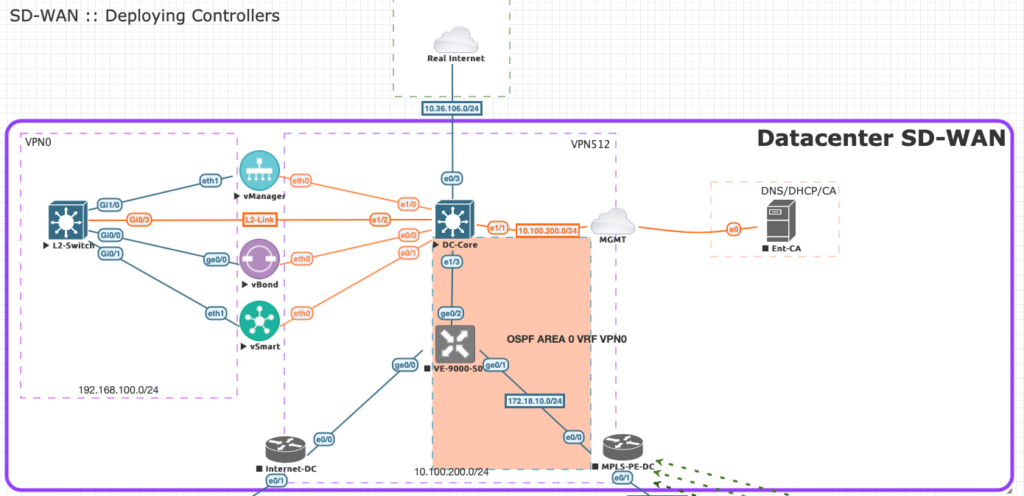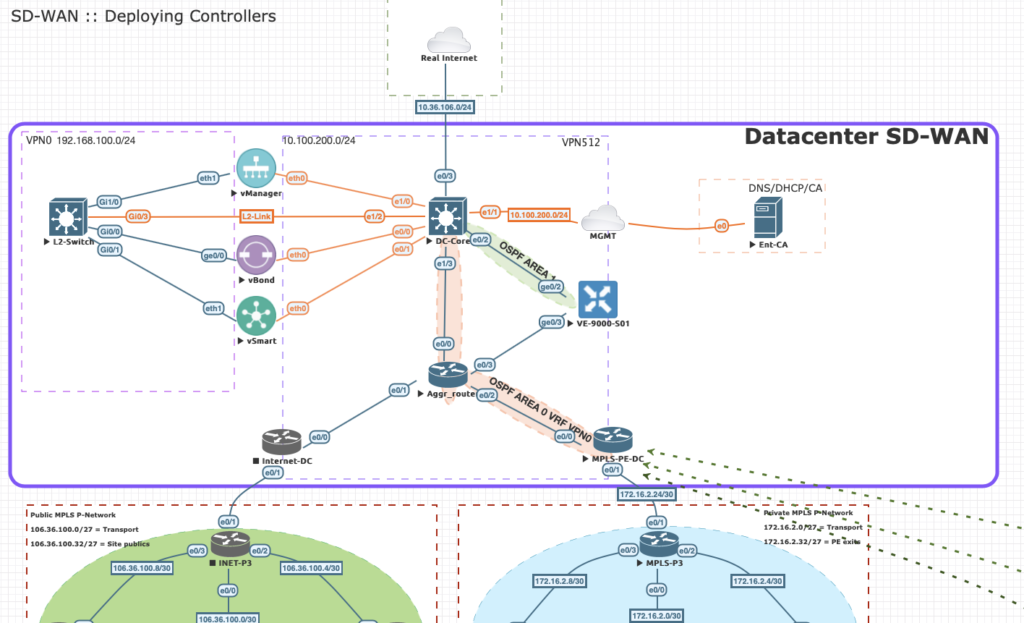During my labbing adventures for SD-WAN I thought creating a SD-WAN network is simple. It actually is when you just replicate Internet and MPLS network by one box and use static routing. There are a lot of training resources that use the simple design to focus on SD-WAN capabilities. And that’s good.
But most engineers like you and me will likely start working with SD-WAN environments or start migrating traditional WAN to SD-WAN. Then a lot more network technology comes into play all of a sudden.
I’ve built my own on-prem lab:

One of the main prerequisites is that SD-WAN WAN Edges need IP reachability to the controllers. It doesn’t really matter how or via what protocol as this will remain the underlay and is invisible for the SD-WAN Fabric.
:: The problem
I started designing my topology in EVE-NG. I created a DC location and some remote sites. One of the traits is that a WAN Edge can replace the CPE device for MPLS or Internet and connect directly to a PE node. That’s not always the case. But let’s continue.
When installing the WAN-Edge I tried to tap into the OSPF configurations from DC-Core to get all the network routes and onboard the vEdge. Great that worked fine with manually building the configuration. OSPF neighbours are up and sharing IP routes with each other and we have ip reachability. But no onboarding happened.
The onboarding process requires the WAN Edge to be able to setup a TLS/DTLS tunnel to the controllers for onboarding.
With our OSPF configuration between DC-Core and VE-9000-S01 and a tunnel-interface on ge0/2 the following happened:
- OSPF neighbour with DC-Core went down
- Withdrawn of IP routes
- Lost reachability to controllers
By removing the Tunnel-interface command OSPF neigbours came back up and IP routes are shared again. Chicken and egg syndrome??
Ok, so either I can use traditional IP connectivity or a tunnel-interface and a lot of manual static routes.
:: Service side versus Transport side
his pushes us to think about how the WAN Edge is meant to be used.
The best way to think about it is to divide a WAN Edge into two parts:
- Services-side: Traditional configuration with OSPF or static to pass IP routes. No tunnel-interfaces
- Transport-side: The place where OMP magic happens. The transport side forms the overlay network and is based in IPsec tunnels. Also they setup a DTLS tunnel to the controllers back in the datacenter. Service-side IP routes are redistributed into OMP to pass over the fabric.
So when the controllers live on the On-Prem Datacenter the local WAN Edge cannot be positioned as a CPE device for MPLS or Internet directly.
:: How to solve it?
To solve this puzzle we just need to add an aggregated device to connect MPLS and Internet circuits to it.
The transport side will be connected to the Aggr_router and will provide tunnel capabilities towards the controllers. The Service side will be connected to the DC-Core.

But hold on for just one second! Basically the same setup!
Not quite! On the Service side we’ve enable OSPF Area 1:
VE-9000-S01# show run vpn 1
vpn 1
router
ospf
timers spf 200 1000 10000
area 1
interface ge0/2
exit
exit
!
!
interface ge0/2
ip address 10.10.10.5/30
no shutdown
!
!
VE-9000-S01# show ospf neighbor
DBsmL -> Database Summary List
RqstL -> Link State Request List
RXmtl -> Link State Retransmission List
SOURCE DEAD
VPN IP ADDRESS INTERFACE ROUTER ID STATE PRIORITY TIMER DBsmL RqstL RXmtL
-------------------------------------------------------------------------------------------------------
1 10.10.10.6 ge0/2 9.9.9.9 full 1 36 0 0 0
VE-9000-S01# sh ip route vpn 1
Codes Proto-sub-type:
IA -> ospf-intra-area, IE -> ospf-inter-area,
E1 -> ospf-external1, E2 -> ospf-external2,
N1 -> ospf-nssa-external1, N2 -> ospf-nssa-external2,
e -> bgp-external, i -> bgp-internal
Codes Status flags:
F -> fib, S -> selected, I -> inactive,
B -> blackhole, R -> recursive, L -> import
PROTOCOL NEXTHOP NEXTHOP NEXTHOP
VPN PREFIX PROTOCOL SUB TYPE IF NAME ADDR VPN TLOC IP COLOR ENCAP STATUS
---------------------------------------------------------------------------------------------------------------------------------------------
1 0.0.0.0/0 ospf E2 ge0/2 10.10.10.6 - - - - F,S
1 10.10.10.4/30 ospf IA ge0/2 - - - - - -
1 10.10.10.4/30 connected - ge0/2 - - - - - F,S
1 10.36.106.0/24 ospf IA ge0/2 10.10.10.6 - - - - F,S
The service side never tunnels back to controllers or other components. It will only make sure all DC routes are advertised in OMP later on.
For the transport side we’ve used to following static config:
VE-9000-S01# sh run vpn 0
vpn 0
interface ge0/1
ip address 172.18.10.2/24
no shutdown
!
interface ge0/3
ip address 10.10.10.10/30
tunnel-interface
encapsulation ipsec
allow-service all
no allow-service bgp
allow-service dhcp
allow-service dns
allow-service icmp
allow-service sshd
allow-service netconf
no allow-service ntp
no allow-service ospf
no allow-service stun
allow-service https
!
no shutdown
!
ip route 0.0.0.0/0 10.10.10.9
!
VE-9000-S01# sh ip route vpn 0
Codes Proto-sub-type:
IA -> ospf-intra-area, IE -> ospf-inter-area,
E1 -> ospf-external1, E2 -> ospf-external2,
N1 -> ospf-nssa-external1, N2 -> ospf-nssa-external2,
e -> bgp-external, i -> bgp-internal
Codes Status flags:
F -> fib, S -> selected, I -> inactive,
B -> blackhole, R -> recursive, L -> import
PROTOCOL NEXTHOP NEXTHOP NEXTHOP
VPN PREFIX PROTOCOL SUB TYPE IF NAME ADDR VPN TLOC IP COLOR ENCAP STATUS
---------------------------------------------------------------------------------------------------------------------------------------------
0 0.0.0.0/0 static - ge0/3 10.10.10.9 - - - - F,S
0 4.1.1.1/32 connected - system - - - - - F,S
0 10.10.10.8/30 connected - ge0/3 - - - - - F,S
Since we have a route (via default) towards our controllers (192.168.100.0/24) and a configured tunnel-interface a control tunnel can be setup towards the vBond, vSmart and vManage.
VE-9000-S01# show control connections
PEER PEER CONTROLLER
PEER PEER PEER SITE DOMAIN PEER PRIV PEER PUB GROUP
TYPE PROT SYSTEM IP ID ID PRIVATE IP PORT PUBLIC IP PORT LOCAL COLOR PROXY STATE UPTIME ID
----------------------------------------------------------------------------------------------------------------------------------------------------------------------------------------
vsmart dtls 1.1.1.3 9000 1 192.168.100.251 12346 192.168.100.251 12346 default No up 0:05:22:26 0
vbond dtls 0.0.0.0 0 0 192.168.100.252 12346 192.168.100.252 12346 default - up 0:05:22:27 0
vmanage dtls 1.1.1.1 9000 0 192.168.100.250 12546 192.168.100.250 12546 default No up 0:04:37:38 0
:: Conclusion
You cannot replace the existing CPE with a WAN Edge when your controllers are behind that device in the datacenter. You must have an extra aggregation point so the “outside” interface of the WAN Edge can setup a tunnel towards the controllers on the “Inside”.
Some things you need to fail multiple times in before cracking the code of learning. And failure is your key to success.

